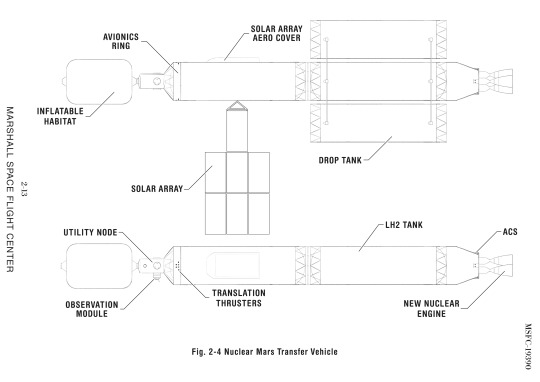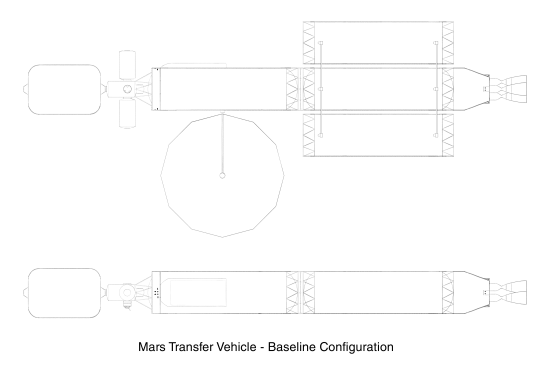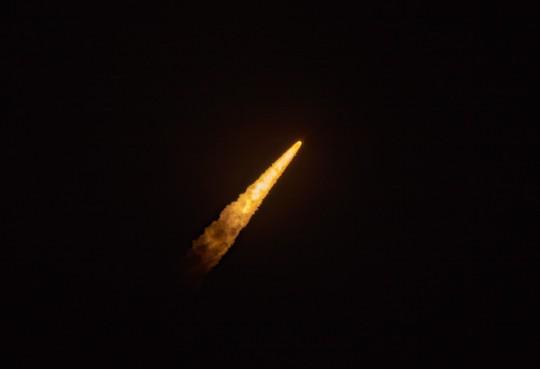Text

MTV initial study, done by Marshall Space Flight Center, by Max

Revised conceptual study for MTV, circa 1982 design freeze, by Max

MTV Minerva being serviced prior to departure on an Olympus mission, as well as OV-106 Intrepid, by Jay
The Olympus Mars Transfer Vehicle was something of a miracle of science and engineering, and showcased some of the greatest cooperation for the entire program as a whole. As important as landing on the surface of Mars is, getting to Mars is a whole different half of the equation, and ensuring that the right equipment would do the job was part of the uphill battle for the program. In the beginning of the design process, it was unclear whether or not the architecture would be chemical, nuclear, or some sort of strange combination of the two. Highly experimental solar electric or even nuclear electric proposals had been thrown around, but it was unclear whether those would be ready in time for the projected late 1990s landing date. Initially, things were dire, as the Olympus Partners stared down the failures of General Atomics to produce a working Valkyrie engine, the key to a reusable nuclear architecture. Ultimately, Lockheed and Naval Reactors would succeed in flying their demonstrator, Way-Seeker, and secure the contract to produce the propulsion section. Boeing would lead the work on Habitat design, a radical new concept for inflatable modules that would enable much greater volume on a single launch. This inflatable habitat would be augmented by a Utility Node, also built by Boeing, and would contain the life support, air lock, and docking systems that would be utilized by ships visiting the MTV. Two Multi Purpose Mission Modules, built by Thales Aerospace, would join the MTV before a mission was due to depart, enabling greater habitable volume and delivering mission specific equipment for the intended landing site. The final component, the Earth Return Lifeboat, would ensure the safety of the crew if something were to go wrong. This capsule would be a large, Apollo CM derived vehicle built by Lockheed and Messerschmitt-Bölkow-Blohm (later Airbus), and could seat a crew of 8.
The MTVs of the Olympus Fleet, Minerva, Prometheus, Hera and Selene, would do their duty well. Each would lead the way in pioneering new triumphs and bring comfort to the crew in times of hardship. They would shelter them from storms, and bring their crews home every time. Even during the disaster of Olympus 9, where all hope seemed lost, Hera gave her all to ensure that her crew would get home safely, sacrificing herself into the inky void of space to throw her passengers home. Towards the end of their usable lives, Minerva, Prometheus and Selene would see continued use supporting Destiny, shuttling cargo landers and crew to and from the lunar surface as infrastructure quickly spread. For the crew of Foundation, the outpost in Noctis, a fleet of new MTVs would emerge, chemical-electric, nuclear and even chemical "cargo sleds" that would push great volumes of equipment. The Americans would lead the charge with their radical Chem-NEP design, the Armstrong class. These would be fully reusable, and leverage design work being done since the start of the program. Japan and Canada would contribute heavily to the Armstrong Class, with logistics modules and robotic arms as their main gifts. Europe's largest contribution would be the Euro-Russian Copernicus Class, a nuclear thermal system based on work done by the Americans in the early days of Olympus. These would be smaller in crew complement but much larger in cargo volume, delivering great aeroshells to the surface. China would also deliver new vehicles, the fully solar-electric Tianzhou class, based on their earlier endeavors in asteroid exploration. These were strictly for cargo, and ensured that Chinese Taikonauts had seats onboard American or European MTVs. This fleet of MTVs would enable a continuous human presence on Mars in the low hundreds throughout the middle of the 21st century.
49 notes
·
View notes
Text
Artemis 1 thunders to orbit following a flawless liftoff of NASA's first Space Launch System rocket


#nasa#space launch system#artemis#artemis 1#orion#sls#rocket#space#spaceflight#moon#luna#launch#rocket launch#moon rocket
24 notes
·
View notes
Text
hi guys :3 this is where i'll be posting my photos from now on!
2 notes
·
View notes